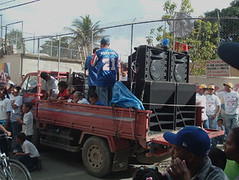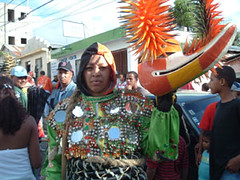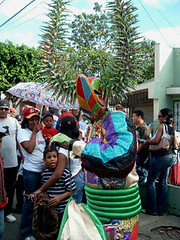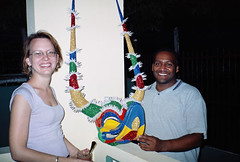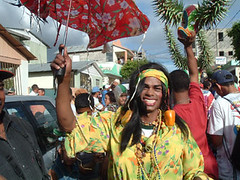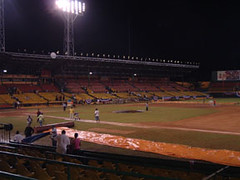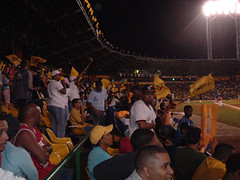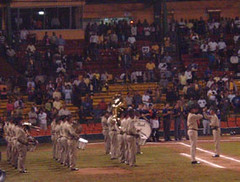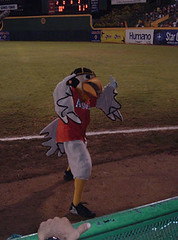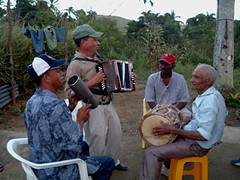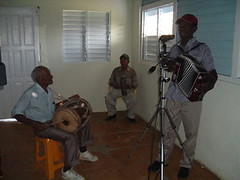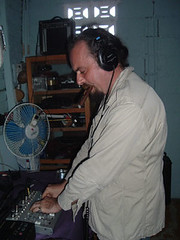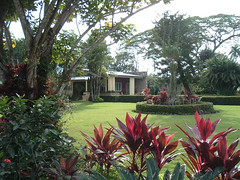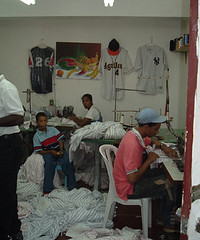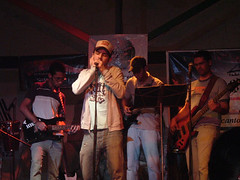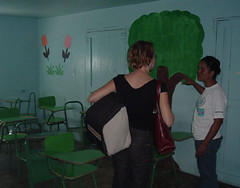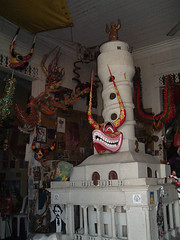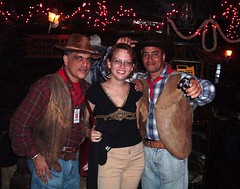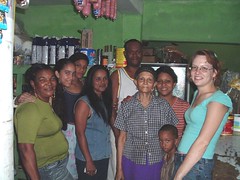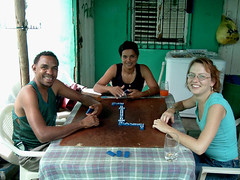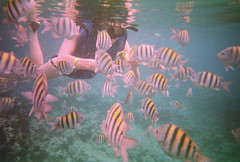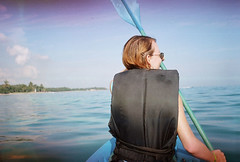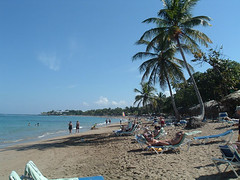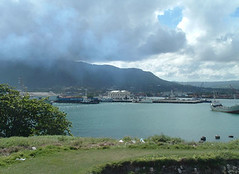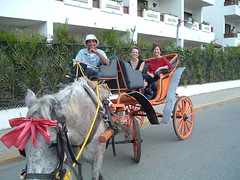This truck was hired by Los Galleros of Cienfuegos.
Tuesday, January 31, 2006
Roba la Gallina
This is a very traditional transvestite character. S/he collects treats from stores along the way and distributes them to the hordes of kids that tag along.
Carnival begins.
1/30/06
If December was fireworks, and Janurary was horns, February is clearly going to be the month of whipcracks. Although since last Thursday I have been suffering from yet another evil cold, on Sunday I was forced to rouse myself from my mosquito-netted cocoon and answer the call of my fellow lechones. It was the first Sunday of the carnival season, and all comparsas (organized carnival groups, generally representing particular neighborhoods) were to head to Los Ciruelitos, a very Carnaval-friendly barrio of Santiago, for the “acalentamiento” (literally “heating up,” or getting people in the Carnaval mood) . When we got there, it was already impossible to drive anywhere because the streets were full of kids running around with whips, trucks and cars blasting recorded music, comparsas in matching t-shirts, and resident onlookers. So we, Los Confraternos de Pueblo Nuevo, ditched our cars as soon as possible and got out into the fray, mingling with the other groups and looking for friends. It didn’t take long before we ran into my friend Jose Reyes and his small son, also looking for parking.
Jose is the guy who got me hooked up with my lechones to begin with. He is a nut for carnaval, actively convincing new lechones to dress up and attending the weekly, city-wide meetings of all the comparsas. While standing around having our ear drums split from the cracks of the twisted-rope whips that all young lechones were brandishing, Jose introduced me to some important carnival characters that I’m hoping to interview at a later date. The first-ever female lechon; a Roba la Gallina (traditional transvestite character); a lechon who has been dressing up for 48 straight carnivals.
Soon the crowd started walking. I hadn’t been told that this would be a parade. In fact, no one gave me any idea at all of what we’d be doing today, so I definitely wasn’t prepared for the kilometers we ended up walking. I did what I could, but it was a little rough with my congested and dizzy head. Anyway, Jose and I fell in behind Los Galleros, a newly invented comparsa (less than 10 years old) from Cienfuegos, widely regarded as the worst neighborhood in Santiago. Like most of the groups, they weren’t wearing their costumes - we’re all still working on putting them together- and were instead wearing matching white t-shirts with their club logo in red on the front and an ad for a radio station, their sponsor, on the back, along with matching yellow baseball caps (also courtesy of their patrons). They were a step up from a lot of the other groups, though, because they had their own speaker-filled truck blasting music for them to dance to as they traversed the parade route. Before we started, it played a number of merengue típico tunes, but once they started moving their deejays switched to orquesta merengues and particularly reggaeton, all specially made for carnival. (I’m still not sure why, but típico groups don’t record carnival tunes.) To these, they took off their hats and jumped up and down in unison, or executed a few simple merengue steps from side to side, also in coordinated fashion. Every couple of blocks, they’d stop to do their “shtick:” while the group ran around in a circle, a couple of them would go into the center of the “ring” and pretend to be egging on their imaginary chickens. I’m told that during actual carnaval, they dress up in “campesino” outfits and bring real roosters, staging actual cockfights along the parade route.
It was interesting to see this neighborhood, an odd mishmash of pleasant-looking, newly plastered and tiled houses, shells of old broken-down cars, and ramshackle huts made mostly of plywood and corrugated tin roofing. In one case, the broken-down car – the bottom half of a formerly white jeep – was on top of the hut. It was also interesting to see how many, how very very many, people are actually involved in carnival, heart and soul, and fun to watch the neighborhood residents coming out to check out the action. But all the walking was really too much for me in my weakened state and I had to hitch a ride back to my car and take my way (the highway) before we’d actually reached the end of the circuit. I was supposed to see the group again the next day – today, that is – for a visit to the tailor and a lesson in the dance of the lechones, but neither happened. More waiting. As Dominicans say: Take it eeeeeaaaasy!
If December was fireworks, and Janurary was horns, February is clearly going to be the month of whipcracks. Although since last Thursday I have been suffering from yet another evil cold, on Sunday I was forced to rouse myself from my mosquito-netted cocoon and answer the call of my fellow lechones. It was the first Sunday of the carnival season, and all comparsas (organized carnival groups, generally representing particular neighborhoods) were to head to Los Ciruelitos, a very Carnaval-friendly barrio of Santiago, for the “acalentamiento” (literally “heating up,” or getting people in the Carnaval mood) . When we got there, it was already impossible to drive anywhere because the streets were full of kids running around with whips, trucks and cars blasting recorded music, comparsas in matching t-shirts, and resident onlookers. So we, Los Confraternos de Pueblo Nuevo, ditched our cars as soon as possible and got out into the fray, mingling with the other groups and looking for friends. It didn’t take long before we ran into my friend Jose Reyes and his small son, also looking for parking.
Jose is the guy who got me hooked up with my lechones to begin with. He is a nut for carnaval, actively convincing new lechones to dress up and attending the weekly, city-wide meetings of all the comparsas. While standing around having our ear drums split from the cracks of the twisted-rope whips that all young lechones were brandishing, Jose introduced me to some important carnival characters that I’m hoping to interview at a later date. The first-ever female lechon; a Roba la Gallina (traditional transvestite character); a lechon who has been dressing up for 48 straight carnivals.
Soon the crowd started walking. I hadn’t been told that this would be a parade. In fact, no one gave me any idea at all of what we’d be doing today, so I definitely wasn’t prepared for the kilometers we ended up walking. I did what I could, but it was a little rough with my congested and dizzy head. Anyway, Jose and I fell in behind Los Galleros, a newly invented comparsa (less than 10 years old) from Cienfuegos, widely regarded as the worst neighborhood in Santiago. Like most of the groups, they weren’t wearing their costumes - we’re all still working on putting them together- and were instead wearing matching white t-shirts with their club logo in red on the front and an ad for a radio station, their sponsor, on the back, along with matching yellow baseball caps (also courtesy of their patrons). They were a step up from a lot of the other groups, though, because they had their own speaker-filled truck blasting music for them to dance to as they traversed the parade route. Before we started, it played a number of merengue típico tunes, but once they started moving their deejays switched to orquesta merengues and particularly reggaeton, all specially made for carnival. (I’m still not sure why, but típico groups don’t record carnival tunes.) To these, they took off their hats and jumped up and down in unison, or executed a few simple merengue steps from side to side, also in coordinated fashion. Every couple of blocks, they’d stop to do their “shtick:” while the group ran around in a circle, a couple of them would go into the center of the “ring” and pretend to be egging on their imaginary chickens. I’m told that during actual carnaval, they dress up in “campesino” outfits and bring real roosters, staging actual cockfights along the parade route.
It was interesting to see this neighborhood, an odd mishmash of pleasant-looking, newly plastered and tiled houses, shells of old broken-down cars, and ramshackle huts made mostly of plywood and corrugated tin roofing. In one case, the broken-down car – the bottom half of a formerly white jeep – was on top of the hut. It was also interesting to see how many, how very very many, people are actually involved in carnival, heart and soul, and fun to watch the neighborhood residents coming out to check out the action. But all the walking was really too much for me in my weakened state and I had to hitch a ride back to my car and take my way (the highway) before we’d actually reached the end of the circuit. I was supposed to see the group again the next day – today, that is – for a visit to the tailor and a lesson in the dance of the lechones, but neither happened. More waiting. As Dominicans say: Take it eeeeeaaaasy!
Baseball!
1/26/06
After a typical week of reading, writing, and just generally hanging out in archives, I tried to actually to some field-type work on Saturday by attending the taping of the weekly TV show “Arriba el merengue.” I’d spoken with the host, who’s been doing this thing for something like 25 years, on the phone and he’d invited me to come by. Actually, he wanted me to play the accordion on his show, but I was hoping to just talk with him a bit first. Anyway, it didn’t matter, because he was sick that day and his substitute was in instead. I watched the performance of one of the live groups booked for that day (Diomedes Acosta) and then went home to get some other work done.
That night, I finally managed to get my butt out the door after 11 PM in order to catch my old friends, the group Aguakate – “el grupo mas internacional” - on tour. I was just in time, really, since they left on Tuesday to go back to New York. Two friends from the Centro Leon, Zoraya and Marta, as well as Marta’s sister, accompanied me to the gig at Tipico Monte Bar. I would describe this place as half bar, half rancho típico (the big thatch-roof structures in which most típico events occur). The owners seem to be trying to accommodate típico music & atmosphere to a slightly more upwardly-mobile crowd, and in fact Marta commented that the place looked much nicer than it had the last time she’d been, three years ago. It still has the thatch roof, but it also has nice tables and chairs, a raised, tiled dance floor, and a stage decorated to look self-consciously “típico:” it is paneled and painted bright blue to look like a rural dwelling (even a little, fake window with shutters is built in). Yet both she and Zoraya (both of them only very occasional típico consumers) thought people there danced “funny” – the crowd danced closer and funkier than would, say, an orquesta merengue crowd. Anyway, Aguakate sounded better than last year – tighter, more interesting arrangements. The lead singer, Chino, looked as wacky as ever. He’s enormous and always wears equally enormous sports jerseys and fluffy Afros. It’s his thing – makes him stand out from the típico crowd. Anyway, we danced it up while waiting for them to start, which didn’t happen until 12:30 – figures. Unfortunately, my camera ran out of batteries in the first two seconds of the show, so I didn’t get any pictures. (At least my minidisc recorder was charged.) We stayed until we got worn out at about 3 AM, at which point Zoraya and I decided to cross the street for a sandwich at the official Monte Bar 24-hour food van. While there, we saw the official “Rafaelito Roman – El Mas Completo” van drive up. Yes, my accordion teacher was also out to grab at 3 AM bite, on his way back from a gig in Puerto Plata.
Because of all this, I couldn’t manage to get up before noon on Sunday. And in the afternoon, I was supposed to meet with my carnival group, but that didn’t happen either. Living in this country certainly involves a lot of waiting! Monday went better, with a fruitful accordion lesson preceded by an interesting discussion about music between Rafaelito, a neighbor, and a student in which they debated the merits of playing a tune on one row or two. Then the neighbor's maybe 7-year-old son rocked out on his accordion. He only new about 3 notes, but boy could he play them! After that, I went to visit friends Chiqui and Laura, but only briefly because I had to get home and get ready for a Major Event.
The calendar year here could almost be marked by a series of sounds. From the constant fireworks of the Christmas-New Year’s season we’ve gone to the honking of the ubiquitous plastic horns of baseball season. Yep- I finally managed to make it to a Dominican baseball game, my first. Good thing, too, as we’re already in the finals here so my opportunities were growing increasingly more limited. I was accompanied by Fausto, the cook at the Centro Leon, who himself used to play on a AA team here until he messed up his shoulder. We got there well ahead of time, giving us plenty of opportunity to check out the military band, drink some beer, and chat with our neighbors in the row ahead. They and Fausto were all Aguiluchos, or supporters of the Santiago team- Las Aguilas Cibaenas. But soon the rest of our row filled up with Liceyistas, supporters of Los Tigres de Licey. For the first four innings they kept quiet, since we were ahead. After that, things got a little out of hand as Licey kept scoring on us. All the blue flags and horns came out, and our neighbor had also brought a megaphone which he used to shout “Fo, fo, fo, fo!” (something like “you stink!”) and greatly annoy the Aguilas, whose bench was right in front of us. The most annoyed was a large, bearded American who, in perfect Dominican Spanish, told him to “get over there!” (to the Licey side). Did you know that, besides Dominican ball players going to the US, US players also come to the DR to play during this winter season? Well, it’s true, I saw at least 3 North American ball players on the home team alone, a surprise to me. Anyway, we lost, but the blow was softened by the fact that finally, at the end of the seventh inning (read: 11:30 PM), the pizza guy at last made it over to our section and I got a long-awaited bite to eat.
My plans for the rest of the week were foiled again, as my evil cold came back in full force on Thursday morning. So I couldn’t make it to a gig I’d planned on that night, and I couldn’t play dominoes with Chiqui and Laura, and I couldn’t make it to the next Arriba el Merengue taping on the next Saturday. I did, however, read about a million articles and re-edit most of my book manuscript. (Yet another momentous occasion had occurred on Monday, when I received a Fed-Ex delivery containing the first – very good – reviews of my work.) Also I caught up on my American Idol watching. Thank God.
After a typical week of reading, writing, and just generally hanging out in archives, I tried to actually to some field-type work on Saturday by attending the taping of the weekly TV show “Arriba el merengue.” I’d spoken with the host, who’s been doing this thing for something like 25 years, on the phone and he’d invited me to come by. Actually, he wanted me to play the accordion on his show, but I was hoping to just talk with him a bit first. Anyway, it didn’t matter, because he was sick that day and his substitute was in instead. I watched the performance of one of the live groups booked for that day (Diomedes Acosta) and then went home to get some other work done.
That night, I finally managed to get my butt out the door after 11 PM in order to catch my old friends, the group Aguakate – “el grupo mas internacional” - on tour. I was just in time, really, since they left on Tuesday to go back to New York. Two friends from the Centro Leon, Zoraya and Marta, as well as Marta’s sister, accompanied me to the gig at Tipico Monte Bar. I would describe this place as half bar, half rancho típico (the big thatch-roof structures in which most típico events occur). The owners seem to be trying to accommodate típico music & atmosphere to a slightly more upwardly-mobile crowd, and in fact Marta commented that the place looked much nicer than it had the last time she’d been, three years ago. It still has the thatch roof, but it also has nice tables and chairs, a raised, tiled dance floor, and a stage decorated to look self-consciously “típico:” it is paneled and painted bright blue to look like a rural dwelling (even a little, fake window with shutters is built in). Yet both she and Zoraya (both of them only very occasional típico consumers) thought people there danced “funny” – the crowd danced closer and funkier than would, say, an orquesta merengue crowd. Anyway, Aguakate sounded better than last year – tighter, more interesting arrangements. The lead singer, Chino, looked as wacky as ever. He’s enormous and always wears equally enormous sports jerseys and fluffy Afros. It’s his thing – makes him stand out from the típico crowd. Anyway, we danced it up while waiting for them to start, which didn’t happen until 12:30 – figures. Unfortunately, my camera ran out of batteries in the first two seconds of the show, so I didn’t get any pictures. (At least my minidisc recorder was charged.) We stayed until we got worn out at about 3 AM, at which point Zoraya and I decided to cross the street for a sandwich at the official Monte Bar 24-hour food van. While there, we saw the official “Rafaelito Roman – El Mas Completo” van drive up. Yes, my accordion teacher was also out to grab at 3 AM bite, on his way back from a gig in Puerto Plata.
Because of all this, I couldn’t manage to get up before noon on Sunday. And in the afternoon, I was supposed to meet with my carnival group, but that didn’t happen either. Living in this country certainly involves a lot of waiting! Monday went better, with a fruitful accordion lesson preceded by an interesting discussion about music between Rafaelito, a neighbor, and a student in which they debated the merits of playing a tune on one row or two. Then the neighbor's maybe 7-year-old son rocked out on his accordion. He only new about 3 notes, but boy could he play them! After that, I went to visit friends Chiqui and Laura, but only briefly because I had to get home and get ready for a Major Event.
The calendar year here could almost be marked by a series of sounds. From the constant fireworks of the Christmas-New Year’s season we’ve gone to the honking of the ubiquitous plastic horns of baseball season. Yep- I finally managed to make it to a Dominican baseball game, my first. Good thing, too, as we’re already in the finals here so my opportunities were growing increasingly more limited. I was accompanied by Fausto, the cook at the Centro Leon, who himself used to play on a AA team here until he messed up his shoulder. We got there well ahead of time, giving us plenty of opportunity to check out the military band, drink some beer, and chat with our neighbors in the row ahead. They and Fausto were all Aguiluchos, or supporters of the Santiago team- Las Aguilas Cibaenas. But soon the rest of our row filled up with Liceyistas, supporters of Los Tigres de Licey. For the first four innings they kept quiet, since we were ahead. After that, things got a little out of hand as Licey kept scoring on us. All the blue flags and horns came out, and our neighbor had also brought a megaphone which he used to shout “Fo, fo, fo, fo!” (something like “you stink!”) and greatly annoy the Aguilas, whose bench was right in front of us. The most annoyed was a large, bearded American who, in perfect Dominican Spanish, told him to “get over there!” (to the Licey side). Did you know that, besides Dominican ball players going to the US, US players also come to the DR to play during this winter season? Well, it’s true, I saw at least 3 North American ball players on the home team alone, a surprise to me. Anyway, we lost, but the blow was softened by the fact that finally, at the end of the seventh inning (read: 11:30 PM), the pizza guy at last made it over to our section and I got a long-awaited bite to eat.
My plans for the rest of the week were foiled again, as my evil cold came back in full force on Thursday morning. So I couldn’t make it to a gig I’d planned on that night, and I couldn’t play dominoes with Chiqui and Laura, and I couldn’t make it to the next Arriba el Merengue taping on the next Saturday. I did, however, read about a million articles and re-edit most of my book manuscript. (Yet another momentous occasion had occurred on Monday, when I received a Fed-Ex delivery containing the first – very good – reviews of my work.) Also I caught up on my American Idol watching. Thank God.
Tuesday, January 17, 2006
afterparty
Jorge on guira, Daniel on tambora, Armando hanging out, and the mayor Emiliano "Papiro" on accordion, grooving after the recording was done.
mayoral merengues
1/15/06
Mom thought and hoped the day would never come, but unfortunately it did – on Thursday she had to leave and head back to Tucson and work. We did the big sendoff with two nights in a row of eating out, and then got up early enough to see the sunrise – something very new for me – and headed to the airport with a car full of luggage, unsure if she’d actually be able to get it all on the plane. Due to a very nice ticket agent, she did, and at one low price! After an airport breakfast featuring cheese-filled rolls, we said our fond farewells, and I went home to spend most of the rest of the day working on preparing an old article for publication. The apartment felt a bit lonely and empty though, a bit depressing, so to cheer myself up I took me out to a movie. “The Wedding Crashers” wasn’t really all it was cracked up to be, but that and an overpriced scoop of mint chip ice cream did help my mood a little. Even in spite of the annoying guy sitting in the row in front of me who felt compelled to comment loudly – in English, no less (for my benefit, apparently) – on all the dumb jokes. Maybe he thought since we were the only two unpartnered moviegoers in the theater we had some kind of mysterious, special bond? Eww.
Friday was uneventful, other than an unsuccessful trip to the baseball stadium to buy tickets for Sunday’s game (sold out, except for overpriced scalpers). Saturday, too, as I spent most of the day sitting around at my mechanic’s, El Negro’s, workshop trying to get my newly re-holed gasoline tank repaired. The most amusing moment during those oh, fourish hours, was when a truck advertising a political candidate went by blasting bachata music out of its enormous sound system, setting off the alarm of a red sports car in front of El Negro’s each time. While waiting there, though, I received a phone call from an Italian filmmaker I’d met at the Centro Leon a month ago, inviting me to his house in the middle of nowhere where he was going to record a CD for a trio of rural típico musicians. I accepted. Then, that night I went to Tonito’s house, the head of my carnival group, to work out the design for my costume on his computer. We are high tech lechones. While we were doing that and burning a couple of CDs of merengue típico and carnival songs, it started pouring rain – thundering and the whole bit. This was bad, because apparently the whole street, one of the traditionally crappy unpaved barrio streets of Santiago, fills up with water like a river at times like this. The rain only lasted for an hour, or maybe less, but by the time we could go outside all the neighbors were out there with shovels trying to unbury their front porches and so-called gutters. And my car was in the middle of it. I started having an attack of déjà vu as we bailed water from my car and tried to wipe out the mud. One thing was better about this time, though, which was that Tonito has a dryer, so his wife got my car’s rugs mostly dry as we worked. Still, it smelled rather unpleasant the next day and sported a light coating of loam over many of the plastic parts.
At any rate, after doing a bit of work at home on Sunday, I headed out to the Styx. I followed Giovanni’s directions fine up to the crappy turnoff the La Torre, a little town just across the state line in the province of La Vega. I successfully passed my first obstacle by donating 20 pesos to a group of people holding a rope across the road in order to collect money to build a new enrramada (a thatch-roof shelter, good for holding dances) for the town. But from there, I didn’t know where to go next, so I went to a roadside stop to have a Pepsi and rest in the shade. I called several times, since Giovanni was supposed to send his son to find me and show me the way to their house. However, his cell phone was off and his land line didn’t seem to be working – I could hear them, but they couldn’t hear me. Eventually we made contact, though, and Rudy came along on his motorbike to show me the way.
Man, what a bad road. I don’t think I went more than 8 mph the whole way – not that I would know, since my speedometer is broken. Anyway, after innumerable potholes, ruts, rocks, ups and downs, we made it … to a place to park. Apparently, that had been the good part of the road. Zoiks! At this point, we had to leave the car and the bike and go on foot: past a field where a herd of noisy goats grazed; down a steep, muddy hill; across a stream, up another steep, muddy hill and past a friendly horse; guided always towards their house by the sounds of accordion, güira, and tambora. The musicians had arrived.
They were already set up and doing a sound check when I walked in: the accordionist standing next to a microphone, the very old tamborero in his very old fedora on a chair about 4 feet away, and the güirero hidden away in the furthest corner. They were almost ready, but not quite: no fuel. Giovanni sent Rudy to buy some Brugal rum at the colmado. Once they were lubricated, they were ready to rock. Meanwhile Giovanni was smoking a big old cigar, bent over a mixing board in the next room as if he were the Wizard of Oz behind his curtain. All the musicians were from Las Canas, a small town down the road. They recorded 10 songs with one accordionist and then switched to a different one for the next 10. The second accordionist turned out to be the mayor of Las Canas. After this all was finished, they took the instruments outside and had a little after-party in the front yard. A number of neighbors came by to enjoy the music (and rum), some of us dancing on the small porch as the sun set. I hadn’t really wanted to tackle the road out in the dark, but it was too much fun to leave any earlier. They had me play a couple of tunes to close the party, and then the musicians on their motorcycles accompanied me down the very dark road to get my car. The mayor then got in my car to direct me as far as the main (paved) road. Slowly but surely, we got there, and I made it back to Santiago with the strains of “El Puente Seco” still echoing in my head.
Mom thought and hoped the day would never come, but unfortunately it did – on Thursday she had to leave and head back to Tucson and work. We did the big sendoff with two nights in a row of eating out, and then got up early enough to see the sunrise – something very new for me – and headed to the airport with a car full of luggage, unsure if she’d actually be able to get it all on the plane. Due to a very nice ticket agent, she did, and at one low price! After an airport breakfast featuring cheese-filled rolls, we said our fond farewells, and I went home to spend most of the rest of the day working on preparing an old article for publication. The apartment felt a bit lonely and empty though, a bit depressing, so to cheer myself up I took me out to a movie. “The Wedding Crashers” wasn’t really all it was cracked up to be, but that and an overpriced scoop of mint chip ice cream did help my mood a little. Even in spite of the annoying guy sitting in the row in front of me who felt compelled to comment loudly – in English, no less (for my benefit, apparently) – on all the dumb jokes. Maybe he thought since we were the only two unpartnered moviegoers in the theater we had some kind of mysterious, special bond? Eww.
Friday was uneventful, other than an unsuccessful trip to the baseball stadium to buy tickets for Sunday’s game (sold out, except for overpriced scalpers). Saturday, too, as I spent most of the day sitting around at my mechanic’s, El Negro’s, workshop trying to get my newly re-holed gasoline tank repaired. The most amusing moment during those oh, fourish hours, was when a truck advertising a political candidate went by blasting bachata music out of its enormous sound system, setting off the alarm of a red sports car in front of El Negro’s each time. While waiting there, though, I received a phone call from an Italian filmmaker I’d met at the Centro Leon a month ago, inviting me to his house in the middle of nowhere where he was going to record a CD for a trio of rural típico musicians. I accepted. Then, that night I went to Tonito’s house, the head of my carnival group, to work out the design for my costume on his computer. We are high tech lechones. While we were doing that and burning a couple of CDs of merengue típico and carnival songs, it started pouring rain – thundering and the whole bit. This was bad, because apparently the whole street, one of the traditionally crappy unpaved barrio streets of Santiago, fills up with water like a river at times like this. The rain only lasted for an hour, or maybe less, but by the time we could go outside all the neighbors were out there with shovels trying to unbury their front porches and so-called gutters. And my car was in the middle of it. I started having an attack of déjà vu as we bailed water from my car and tried to wipe out the mud. One thing was better about this time, though, which was that Tonito has a dryer, so his wife got my car’s rugs mostly dry as we worked. Still, it smelled rather unpleasant the next day and sported a light coating of loam over many of the plastic parts.
At any rate, after doing a bit of work at home on Sunday, I headed out to the Styx. I followed Giovanni’s directions fine up to the crappy turnoff the La Torre, a little town just across the state line in the province of La Vega. I successfully passed my first obstacle by donating 20 pesos to a group of people holding a rope across the road in order to collect money to build a new enrramada (a thatch-roof shelter, good for holding dances) for the town. But from there, I didn’t know where to go next, so I went to a roadside stop to have a Pepsi and rest in the shade. I called several times, since Giovanni was supposed to send his son to find me and show me the way to their house. However, his cell phone was off and his land line didn’t seem to be working – I could hear them, but they couldn’t hear me. Eventually we made contact, though, and Rudy came along on his motorbike to show me the way.
Man, what a bad road. I don’t think I went more than 8 mph the whole way – not that I would know, since my speedometer is broken. Anyway, after innumerable potholes, ruts, rocks, ups and downs, we made it … to a place to park. Apparently, that had been the good part of the road. Zoiks! At this point, we had to leave the car and the bike and go on foot: past a field where a herd of noisy goats grazed; down a steep, muddy hill; across a stream, up another steep, muddy hill and past a friendly horse; guided always towards their house by the sounds of accordion, güira, and tambora. The musicians had arrived.
They were already set up and doing a sound check when I walked in: the accordionist standing next to a microphone, the very old tamborero in his very old fedora on a chair about 4 feet away, and the güirero hidden away in the furthest corner. They were almost ready, but not quite: no fuel. Giovanni sent Rudy to buy some Brugal rum at the colmado. Once they were lubricated, they were ready to rock. Meanwhile Giovanni was smoking a big old cigar, bent over a mixing board in the next room as if he were the Wizard of Oz behind his curtain. All the musicians were from Las Canas, a small town down the road. They recorded 10 songs with one accordionist and then switched to a different one for the next 10. The second accordionist turned out to be the mayor of Las Canas. After this all was finished, they took the instruments outside and had a little after-party in the front yard. A number of neighbors came by to enjoy the music (and rum), some of us dancing on the small porch as the sun set. I hadn’t really wanted to tackle the road out in the dark, but it was too much fun to leave any earlier. They had me play a couple of tunes to close the party, and then the musicians on their motorcycles accompanied me down the very dark road to get my car. The mayor then got in my car to direct me as far as the main (paved) road. Slowly but surely, we got there, and I made it back to Santiago with the strains of “El Puente Seco” still echoing in my head.
Tuesday, January 10, 2006
tailors
When I went to get measured for my carnival costume, these guys were hard at work on a bunch of baseball jerseys.
Museo Folklorico Tomas Morel
A little part of the wacky collection of this small yet fantastic museum.
Odd museums, nice sneakers
1/9/05
Had my second (and my mom’s first) Dominican cooking class with Carmen last Thursday. This time we learned how to make Pastelon, or casserole, of ripe plantains and eggplant, one of our favorite dishes from the last time we ate at the Roman house. We didn’t expect to eat there – other than the products of our cooking experiment - and so had just had a huge Chinese lunch just before going. However, when we showed up we found locrio (mixed rice dish), pescado en escabeche, guandules (lentils), and green salad already underway, and knew we needed to starting looking for additional stomach space. After a glass of ponche (sort of a Dominican egg nog, but less eggy) and a couple of card games as we waited, we got to work. About 45 minutes later our pastelon was done, and tasty it was! I still think Carmen needs to write her own cookbook, but she tells me she’d rather open a restaurant.
Friday was the day of the three kings or reyes magos (epiphany, on our calendar), but we forgot that until we’d already hit the road that afternoon. In the morning, we’d checked our email and visited two museums. First, the Museo Folklorico de Tomas Morel, now run by Morel, Jr., or Tomasito and the home of a fantastic collection of Santiago carnival masks as well as an odd jumble of other items from Nico Lora’s accordion to hundred-year-old santos de palo (religious icons); from an old-fashioned water filter (pour the water into a volcanic stone basin at the top and wait for it to seep through to the clay pot underneath) to a bent-wire model showing how to make casabe. There are also three resident cats (we met one named Yoku, a name Tomasito claims to have taken from a Tarzan movie) and a small stage outside for holding programs under a huge amapola tree. Really a fantastic place, the only problem is one never knows when it might be open. (This was in fact our fourth try.)
After that, we went to visit the museum at “the monument,” Santiago’s central edifice –a two-story pedestal supporting a huge column on which is perched a very stylized statue of a woman? with her arms upraised as if to signal the landing of UFOs. One of my guide books said this statue was of Trujillo, since he was the one who built this thing; the other suggested it was an angel. Neither, apparently, is the case –our guide told us it was Maria Trinidad Sanchez, the Betsy Ross of the Dominican Republic. Although, I halfway wonder if the answer might change if we went back on a different day. Anyway, the stairway up to the second-floor museum and the top of the monument was closed, as usual, but instead we paid this guy for a tour of what he called “three museums – the monument, a taino museum, and a carnival museum.” I’d never heard of any three museums up here, but what the heck, I figured – at least it was for a good cause, since supposedly he was collecting money to buy uniforms for a little league team. Well, the “monument museum” consisted of the first floor of the monument, which I could have seen from outside, but he did provide us with one tantalizing bit of information, showing us where a secret escape passage constructed by Trujillo began (it lets out at a nearby fort). The guy was paranoid, but with good reason. Unfortunately, no one is allowed in the passage, so we continued on to the “taino museum,” consisting of a bunch of rock sculptures with faces painted on in neo-primitive style. These were actually outside the monument on one of the landscaped tiers that surrounds it and I’d seen them a hundred times before. Next and last we saw the “carnival museum,” which was a single carnival mask in pepinero style attached to a signpost at the foot of the monument hill. Located in no building, having no labeling, and in fact consisting not of collections but of single objects, these “exhibits” brought into question the very definition of museums! Truly fascinating and philosophically intriguing.
Clearly it was time to get out of town and so we got on the Luperon “highway” (about 1.5 lanes of moderately good paved road). After a few kilometers lunchtime hunger set in and that’s when we noticed just about everything was closed for the holiday. Oops. (Carmen told us that in the DR the holiday is really only celebrated by the upper classes, who give gifts to their children then, while the average joes don’t do much – but still, any excuse to have a day off of work is a good one.) Surely we could find something in Licey. OK, maybe not, but definitely in Moca, only 10 km away. Hmm… well, Salcedo was bound to have something. And it did, thankfully. We found a rather nice place – even certified by the “Ruta del Café,” a Tourism Dept endeavor to recommend reliable roadside restaurants – right by the town square and church. The church was nice: though they apparently could not afford stained glass windows, they’d found a satisfactory solution in open brickwork. This allowed air and light in, along with the curious gazes of windowpeepers such as ourselves. Outside the church, there was a lifesize nativity scene made with the wicker-work animals that seem to be ubiquitous here, and a small stage decorated with a metal violin where musical performances are apparently held. Returning to El Carnero, we ordered a Dominican pizza, juice, and a salad (Mom distrusted the greens, but I’ve never had any trouble eating salads here). While awaiting our food, I conversed with the waiter about my research. I’d come to town in search of people who knew Rafael Petiton Guzman, a composer of the 1930s-60s whose family had contacted me about doing research on him and analyzing/publicizing his compositions. Luck was with me – our waiter, Luis, knew exactly who this was. “Don Fello Guzman?” he asked. “My uncle used to take saxophone lessons with him!” His uncle, unfortunately, had died of the drink some decades before, but Luis called his father to see what he could find. In this way, we learned that Petiton’s sister, Amparo, used to live on this very spot – Luis showed me the one wall that remained of the original wooden house. Also, Pablito Torres, a son of Amparo, still lives here and has an iron-working shop just two blocks away. Score!
From there, we went on to speak of politics, always a big topic in Salcedo. This was a hotbed of resistance in the 1950s, since the famous Mirabal sisters and their husbands lived just outside of town in Ojo de Agua and their group of resistance fighters, 14 de Junio, was based here. Apparently, Luis’s father had belonged to this group, and was thus lucky to be alive, since many other members had been assassinated by Trujillo’s henchmen as were the Mirabals. The other reason we wanted to visit Salcedo was to see the Mirabal sisters’ house and museum, which Luis assured us would be open, and which was only two kilometers down this same road. After lunch we followed his directions, which led us right to the spot (though it was really more like 3 km). If you plan to visit: continue east on the highway out of Salcedo towards Tenares. Just after a Texaco station on the left and a sign pointing to “El Conuco” on the right, you’ll see the entrance to the museum.
The museum is actually the house where the sisters lived with their mother for the last 10 months of their lives, during the time that their husbands were all political prisoners. They were in and out of prison themselves, and one of the spookiest exhibits was of the sculptures one of the sisters did while in jail – disembodied heads, decapitated torsos, and a pair of hands, which the guide told us were meant to symbolize the injustices of prison, where some of the women’s fingernails were torn out as punishment for their dissident beliefs. It was a beautiful house, though, as they were clearly a family of means, even having one of the first modern European-style bathrooms in the country (imported from Australia), and two separate kitchens: one in the main house for daily use, fitted with a refrigerator and a coal stove, which also supplied hot water to the bathroom, and a rustic woodfired version in an outbuilding, for the use of the staff and when large groups of guests came. The house was full of evidence of the sisters’ many talents: the paintings of one, charcoal drawings by another, Minerva’s thesis for the law degree she was never allowed to use, and embroideries and sewing projects done by all three. Next to these hung the bloodied handkerchief used to clean their bodies after they’d been beaten and thrown into a ditch by Trujillo’s henchmen, and the braid the only surviving sister cut from Patria’s head after her death. It was a sad reminder of the country’s bloody history that seems so distant from today’s daily life, but important to see the facts about tyranny. We took a couple of pictures in the lovely gardens where the three sisters’ and one of their husband’s bodies have been reinterred after moving them from the Salcedo cemetery in 2000. Having seen all this, I guess it’s time to re-read “In the time of the butterflies”!
We took a different route back to Santiago, since we were hoping to find the shops selling wooden utensils that were closed when we were coming back from Santo Domingo. We did find them, at the Cruce del Pino – about halfway between La Vega and Bonao - and just in time, since it was near sunset. We purchased some dishes made of lightweight amapola wood, some painted with pastoral scenes, and some in fish shapes, as well as a couple of painted gourds, all done by artists in the Bonao area. These were all fairly inexpensive and quite different from the tourist art sold on the streets and in the mercados of either Santiago or the capital. The lack of avenues of distribution for folk arts in this country is really kind of odd – these things, along with the great rag rugs we bought up in the mountain pass, are all readily available roadside but never seem to make it to the cities.
Hoping to catch some merengue típico at the Car Wash, we headed there directly upon our return to Santiago. Unfortunately, no one was playing today. Instead, we decided to try out one of the many neighborhood bars in my area that I still hadn’t made it to. I chose one with the intriguing name of “Te Matare, Batista,” or “I’ll kill you, Batista!” I had been thinking this must either be a literary reference (it looked like that kind of a place) or some ancient Cuban saying. Neither was the case. The waiter told me it was something the owner always said affectionately when he called up his sister-in-law, whose last name was Batista: I’ll kill you… with hugs and kisses. Not the revolutionary political slogan I was hoping for, but a cute story. A couple of frias and a cheese appetizer allowed us to soak up the Batistan atmosphere before heading over to Helados Bon and purchasing the ice cream that would stand in for dinner that night.
It was a mellow weekend, by decree of the weather, mostly. Went to the gym and the movies on Saturday. We’d planned on attending a baseball game on Sunday but it got rained out, and it’s still raining now, on Tuesday morning as I write this. Just as well, since I woke up with a head cold on Sunday and am still suffering from it – health to match the weather. Sort of put a damper on our “last hurrah” plans for Mom’s last week here, though. At least we got out to hear some music last night with Luis and Pilucho, our friends from the mountain expedition. Percussionist Felle Vega was hosting a jazz jam session at the cleverly named Bar Code downtown, as he does every Monday. (On the inside, the bar’s name is reconfigured on a poster that tells the audience they are actually at the Barco de Jazz.) The music was good – jazz and Latin jazz tunes played on a wacky combination of instruments, dictated by whoever shows up I think. When the jazzistas took a break a 5-man rock band took the stage. They were very professional and quite impressive, as Felle himself pointed out when they’d finished. “When we started this event five years ago,” Felle noted, “a lot of groups would come down to play who really had just gotten together. Now the groups are very well-rehearsed, they really know what they’re doing and aren’t just making it up as they go along. Also, I don’t know if you noticed, but they have invested a lot of money in their tennis shoes.” Which was true.
Had my second (and my mom’s first) Dominican cooking class with Carmen last Thursday. This time we learned how to make Pastelon, or casserole, of ripe plantains and eggplant, one of our favorite dishes from the last time we ate at the Roman house. We didn’t expect to eat there – other than the products of our cooking experiment - and so had just had a huge Chinese lunch just before going. However, when we showed up we found locrio (mixed rice dish), pescado en escabeche, guandules (lentils), and green salad already underway, and knew we needed to starting looking for additional stomach space. After a glass of ponche (sort of a Dominican egg nog, but less eggy) and a couple of card games as we waited, we got to work. About 45 minutes later our pastelon was done, and tasty it was! I still think Carmen needs to write her own cookbook, but she tells me she’d rather open a restaurant.
Friday was the day of the three kings or reyes magos (epiphany, on our calendar), but we forgot that until we’d already hit the road that afternoon. In the morning, we’d checked our email and visited two museums. First, the Museo Folklorico de Tomas Morel, now run by Morel, Jr., or Tomasito and the home of a fantastic collection of Santiago carnival masks as well as an odd jumble of other items from Nico Lora’s accordion to hundred-year-old santos de palo (religious icons); from an old-fashioned water filter (pour the water into a volcanic stone basin at the top and wait for it to seep through to the clay pot underneath) to a bent-wire model showing how to make casabe. There are also three resident cats (we met one named Yoku, a name Tomasito claims to have taken from a Tarzan movie) and a small stage outside for holding programs under a huge amapola tree. Really a fantastic place, the only problem is one never knows when it might be open. (This was in fact our fourth try.)
After that, we went to visit the museum at “the monument,” Santiago’s central edifice –a two-story pedestal supporting a huge column on which is perched a very stylized statue of a woman? with her arms upraised as if to signal the landing of UFOs. One of my guide books said this statue was of Trujillo, since he was the one who built this thing; the other suggested it was an angel. Neither, apparently, is the case –our guide told us it was Maria Trinidad Sanchez, the Betsy Ross of the Dominican Republic. Although, I halfway wonder if the answer might change if we went back on a different day. Anyway, the stairway up to the second-floor museum and the top of the monument was closed, as usual, but instead we paid this guy for a tour of what he called “three museums – the monument, a taino museum, and a carnival museum.” I’d never heard of any three museums up here, but what the heck, I figured – at least it was for a good cause, since supposedly he was collecting money to buy uniforms for a little league team. Well, the “monument museum” consisted of the first floor of the monument, which I could have seen from outside, but he did provide us with one tantalizing bit of information, showing us where a secret escape passage constructed by Trujillo began (it lets out at a nearby fort). The guy was paranoid, but with good reason. Unfortunately, no one is allowed in the passage, so we continued on to the “taino museum,” consisting of a bunch of rock sculptures with faces painted on in neo-primitive style. These were actually outside the monument on one of the landscaped tiers that surrounds it and I’d seen them a hundred times before. Next and last we saw the “carnival museum,” which was a single carnival mask in pepinero style attached to a signpost at the foot of the monument hill. Located in no building, having no labeling, and in fact consisting not of collections but of single objects, these “exhibits” brought into question the very definition of museums! Truly fascinating and philosophically intriguing.
Clearly it was time to get out of town and so we got on the Luperon “highway” (about 1.5 lanes of moderately good paved road). After a few kilometers lunchtime hunger set in and that’s when we noticed just about everything was closed for the holiday. Oops. (Carmen told us that in the DR the holiday is really only celebrated by the upper classes, who give gifts to their children then, while the average joes don’t do much – but still, any excuse to have a day off of work is a good one.) Surely we could find something in Licey. OK, maybe not, but definitely in Moca, only 10 km away. Hmm… well, Salcedo was bound to have something. And it did, thankfully. We found a rather nice place – even certified by the “Ruta del Café,” a Tourism Dept endeavor to recommend reliable roadside restaurants – right by the town square and church. The church was nice: though they apparently could not afford stained glass windows, they’d found a satisfactory solution in open brickwork. This allowed air and light in, along with the curious gazes of windowpeepers such as ourselves. Outside the church, there was a lifesize nativity scene made with the wicker-work animals that seem to be ubiquitous here, and a small stage decorated with a metal violin where musical performances are apparently held. Returning to El Carnero, we ordered a Dominican pizza, juice, and a salad (Mom distrusted the greens, but I’ve never had any trouble eating salads here). While awaiting our food, I conversed with the waiter about my research. I’d come to town in search of people who knew Rafael Petiton Guzman, a composer of the 1930s-60s whose family had contacted me about doing research on him and analyzing/publicizing his compositions. Luck was with me – our waiter, Luis, knew exactly who this was. “Don Fello Guzman?” he asked. “My uncle used to take saxophone lessons with him!” His uncle, unfortunately, had died of the drink some decades before, but Luis called his father to see what he could find. In this way, we learned that Petiton’s sister, Amparo, used to live on this very spot – Luis showed me the one wall that remained of the original wooden house. Also, Pablito Torres, a son of Amparo, still lives here and has an iron-working shop just two blocks away. Score!
From there, we went on to speak of politics, always a big topic in Salcedo. This was a hotbed of resistance in the 1950s, since the famous Mirabal sisters and their husbands lived just outside of town in Ojo de Agua and their group of resistance fighters, 14 de Junio, was based here. Apparently, Luis’s father had belonged to this group, and was thus lucky to be alive, since many other members had been assassinated by Trujillo’s henchmen as were the Mirabals. The other reason we wanted to visit Salcedo was to see the Mirabal sisters’ house and museum, which Luis assured us would be open, and which was only two kilometers down this same road. After lunch we followed his directions, which led us right to the spot (though it was really more like 3 km). If you plan to visit: continue east on the highway out of Salcedo towards Tenares. Just after a Texaco station on the left and a sign pointing to “El Conuco” on the right, you’ll see the entrance to the museum.
The museum is actually the house where the sisters lived with their mother for the last 10 months of their lives, during the time that their husbands were all political prisoners. They were in and out of prison themselves, and one of the spookiest exhibits was of the sculptures one of the sisters did while in jail – disembodied heads, decapitated torsos, and a pair of hands, which the guide told us were meant to symbolize the injustices of prison, where some of the women’s fingernails were torn out as punishment for their dissident beliefs. It was a beautiful house, though, as they were clearly a family of means, even having one of the first modern European-style bathrooms in the country (imported from Australia), and two separate kitchens: one in the main house for daily use, fitted with a refrigerator and a coal stove, which also supplied hot water to the bathroom, and a rustic woodfired version in an outbuilding, for the use of the staff and when large groups of guests came. The house was full of evidence of the sisters’ many talents: the paintings of one, charcoal drawings by another, Minerva’s thesis for the law degree she was never allowed to use, and embroideries and sewing projects done by all three. Next to these hung the bloodied handkerchief used to clean their bodies after they’d been beaten and thrown into a ditch by Trujillo’s henchmen, and the braid the only surviving sister cut from Patria’s head after her death. It was a sad reminder of the country’s bloody history that seems so distant from today’s daily life, but important to see the facts about tyranny. We took a couple of pictures in the lovely gardens where the three sisters’ and one of their husband’s bodies have been reinterred after moving them from the Salcedo cemetery in 2000. Having seen all this, I guess it’s time to re-read “In the time of the butterflies”!
We took a different route back to Santiago, since we were hoping to find the shops selling wooden utensils that were closed when we were coming back from Santo Domingo. We did find them, at the Cruce del Pino – about halfway between La Vega and Bonao - and just in time, since it was near sunset. We purchased some dishes made of lightweight amapola wood, some painted with pastoral scenes, and some in fish shapes, as well as a couple of painted gourds, all done by artists in the Bonao area. These were all fairly inexpensive and quite different from the tourist art sold on the streets and in the mercados of either Santiago or the capital. The lack of avenues of distribution for folk arts in this country is really kind of odd – these things, along with the great rag rugs we bought up in the mountain pass, are all readily available roadside but never seem to make it to the cities.
Hoping to catch some merengue típico at the Car Wash, we headed there directly upon our return to Santiago. Unfortunately, no one was playing today. Instead, we decided to try out one of the many neighborhood bars in my area that I still hadn’t made it to. I chose one with the intriguing name of “Te Matare, Batista,” or “I’ll kill you, Batista!” I had been thinking this must either be a literary reference (it looked like that kind of a place) or some ancient Cuban saying. Neither was the case. The waiter told me it was something the owner always said affectionately when he called up his sister-in-law, whose last name was Batista: I’ll kill you… with hugs and kisses. Not the revolutionary political slogan I was hoping for, but a cute story. A couple of frias and a cheese appetizer allowed us to soak up the Batistan atmosphere before heading over to Helados Bon and purchasing the ice cream that would stand in for dinner that night.
It was a mellow weekend, by decree of the weather, mostly. Went to the gym and the movies on Saturday. We’d planned on attending a baseball game on Sunday but it got rained out, and it’s still raining now, on Tuesday morning as I write this. Just as well, since I woke up with a head cold on Sunday and am still suffering from it – health to match the weather. Sort of put a damper on our “last hurrah” plans for Mom’s last week here, though. At least we got out to hear some music last night with Luis and Pilucho, our friends from the mountain expedition. Percussionist Felle Vega was hosting a jazz jam session at the cleverly named Bar Code downtown, as he does every Monday. (On the inside, the bar’s name is reconfigured on a poster that tells the audience they are actually at the Barco de Jazz.) The music was good – jazz and Latin jazz tunes played on a wacky combination of instruments, dictated by whoever shows up I think. When the jazzistas took a break a 5-man rock band took the stage. They were very professional and quite impressive, as Felle himself pointed out when they’d finished. “When we started this event five years ago,” Felle noted, “a lot of groups would come down to play who really had just gotten together. Now the groups are very well-rehearsed, they really know what they’re doing and aren’t just making it up as they go along. Also, I don’t know if you noticed, but they have invested a lot of money in their tennis shoes.” Which was true.
Friday, January 06, 2006
Happy 2006
1/5/05
After King Kong, the rest of last week was fairly uneventful. We took Luis, our guide for the Valle del Tetero trip, out to a “thank you” dinner at Amici, the Italian restaurant across the street. This place never seems to get any business, so it was a bit odd to notice they’d taken their sign down – the only little bit of advertising they had. I guess they like to be exclusive. I only knew about it because it’s directly across the street from my place! The food is excellent (and accordingly pricey), though, made by this guy Alvaro from Milan and his Dominican wife. Alvaro told us they recently celebrated their restaurant’s second anniversary with an invitation-only party; unfortunately we missed it because we were gone. To make up, he prepared us a special mixed platter of appetizers – blue cheese puffs, grilled eggplant, caprese, and some kind of beef and caper thing for the meat eaters. The eggplant was amazing, so we asked him for his secret. He slices it ultrathin on one of those slicing machines, then grills it quickly - just about 10 seconds on each side – in a grilling pan. Now that it’s been dried out, he forces it to rehydrate in a dish of vinaigrette for 24 hours. Then, wrap it around a little piece of cheese and serve! (He wouldn’t give us his secret house vinaigrette recipe, but he did tell us a vinaigrette should always be one-third vinegar and one-third oil.)
We enjoyed the house wine until our next course showed up – Luis and I both got the lasagnette with spinach and shrimp. This was a stack of thin lasagna noodle pancakes interspersed with the aforementioned ingredients and a light cream sauce, very tasty. Finally, dessert. Mom had the marmalade crepes and Luis and I once again agreed on the semifroid – a half-frozen whipped cream cake, chocolate on the bottom and semisweet cream on top with a few little chocolate chips thrown in. Sooooo good. But that wasn’t all. We couldn’t go without having some more of Alvaro’s homemade limoncello, to send us off to bed happy. Luis gave Amici two thumbs up.
Next day we kept up the eating frenzy, since Mom wanted me to show her how to make the two Dominican dishes I’ve so far learned to prepare. They turned out pretty good, if I do say so myself. Unfortunately, that’s about all we could do with the day since, after eating lunch out, I got hives from something or another and we had to go home again. Luckily, I woke up feeling fine the next day (if somewhat sleep deprived), since it was December 31 and time to celebrate! We did so by having our friend Juan Miguel, who teaches at the university here and was responsible for finding my apartment, over for a brunch of pancakes, home fries, eggs, and mimosas. (Having lived for a year with a Mormon family in Mesa – really! – he finds he misses American breakfasts.) After that, we went to visit another friend, Chiqui Taveras, a tipico musician in Ingenio Arriba, and his wife Laura. It was his birthday so we brought him a cake and some fudge. They’d promised to teach me to play dominoes, so pretty soon we found ourselves embroiled in a three-hour Presidente-fueled game, me and Chiqui versus mom and Laura. Chiqui and I started off OK at first, but neither of us seem to have the concentration required for counting tiles, so soon Laura and mom were brutally kicking our butts. This got our attention and we started putting more effort into the thing, but (a) I had no luck at all and kept getting impossible hands and (b) my mom kept cruelly playing only tiles that were of no use to me. Thus, Chiqui and I lost six or seven games in a row! But we all enjoyed slapping the dominoes down hard, Dominican style, and yelling “Chiiiiiiiiiiiivo! Chivero!” (Goat!!) every time Chiqui tried to pull one over on us by playing an inappropriate tile.
Chiqui had to play a gig that night in another town, and while we wanted to go we were also extremely sleepy and a bit worried about all the drunk drivers on the street, so decided to give it a pass. Instead we went to Kukara Macara, the famous Dominican cowboy restaurant. There is a John Wayne poster on the wall and the waiters all wear chaps and six-shooters. We ate seafood and plantains while soaking up the décor and the loud orquesta merengue music. It was quite the combination. They also put on one US country song in the middle of that. I guess it was their nod to “cultural authenticity.”
Kukara Macara is right across from the monument, so we wandered up there to check out the scene. It was quite the happening place, and soon we saw why – a couple of sidewalks were blocked off and guarded by fire department personnel, since they were full of rocket launchers for the midnight display. We decided this was a bit too close for comfort and headed home, taking careful note of the enormous bottle rockets and other “fuegos artificiales” being sold on every corner. Somehow (perhaps by virtue of the many loud explosions going off everywhere) we managed to keep our heavy eyelids open til midnight, at which point we went out onto our absent neighbor’s porch to check out the monumental fireworks. They were quite impressive. But they weren’t the only display – people all over the place, including right next to our house, seemed to have invested a significant amount of money in purchasing professional-level pyrotechnics, which they were setting off wherever they happened to be at midnight. It sounded like we were either in a war zone or in Rome, since it was very reminiscent of a New Year’s we spent there back in 1992.
Using earplugs and sleeping pills, we actually slept through the rest of the explosive festivities, enabling us to get up at a decent hour and head back to Chiqui and Laura’s for a big lunch and a dominoes rematch. Laura had prepared rice and beans, green/cabbage salad, stewed pork-ground beef for the carnivores, and a macaroni-tuna salad whose recipe she shared with us (yes- this, too, is Dominican cooking). To drink, she mixed fresh juice of bitter oranges with a packet of strawberry drink mix to produce a thirst-quenching combination. Once our stomachs were full, we got back down to business, that of dominoes, during which Chiqui and I lost another couple of quick rounds to the evil domino queens. Soon it was time to go to Moca, anyway, so at least it was over fast.
We had agreed to drive Laura to Moca to pick up their son and daughter, who’d been spending their vacation with Laura’s sister, mother, and other family members in that small ciabeno town. It wasn’t a long way but the abominable road conditions and rain turned it into an hour’s drive. Really, this was one of the worst roads I’d been on, missing significant lengths of pavement, and when paved, in possession of enormous potholes. (That reminds me, a sinkhole recently appeared in a major street in my very own Santiago neighborhood. People started sticking things in it to make sure drivers would see the hazard, and pretty soon it looked quite festive indeed, sporting a log wearing a paint can hat, a broom, and some Christmas decorations.) It was a pretty drive though, through little agricultural towns, groves of plantains trees, tobacco-drying houses, and finally past the somewhat less scenic chicken-and-egg farm. Turning off the main “highway,” we headed up a steep hill and arrived at Laura’s sister’s colmado and house where we spent a pleasant couple of hours conversing with relatives, getting hit with things from a two-year-old’s slingshot, greeting the church ladies who came by to pray with the sister’s elderly mother-in-law, watching the older kids play Super Mario Brothers on a 1986-vintage Nintendo, examining the jiguera (giant gourd) tree across the way, and seeing the new apartment the family was building on top of the colmado. If the bathroom had been finished, they would have moved in already, but as it was they were still living in the old blue-and-pink wooden structure next door. We took pictures with the family behind the counter of the colmado, where flies buzzed around the pieces of auyama squash sitting on the elderly scale, and then had to cut our visit short since it was getting near dark. Laura, her two kids, and her mother all piled into the back seat of my luxurious 1984 Honda Civic and we hit the road – much faster this time, now that I’d learned where the major holes were located and could avoid them.
When we got back we ate more of the same and then played a couple rounds of dominoes with Laura’s mom – this time, she partnered with me and mom with Chiqui. We did alright but there was still no beating mom, the domino shark. (Is there a saying for “lucky at dominoes…” ?) Then we quickly ate some of Laura’s rice pudding (boil rice with cinnamon and nutmeg, when it’s nearly done add milk, a can of Carnation, and butter; garnish with raisins) and ran off to La Tinaja, since we’d promised Rafaelito we’d make it to his show that night and we were cutting it close. No worry – things had gotten a late start there anyway and we missed none of the típico goodness. For some reason, though, La Union Tipica (the group formed by Narcisco “El Pavarotti” and Pedrito Reynoso, who usually play after Rafaelito) didn’t show up or was late, so we didn’t get to hear them.
Since then, we’ve mostly been trying to get a bit of work and shopping done before mom leaves next week. It will be weird to be alone again! We did get in another movie, though – Harry Potter, which just opened here last week. Potter seems to be just as popular among Dominicans as it is in the US, as there were longer lines for this film than I’d seen for any other. During the show people were absolutely, and atypically, quiet – except for a few comments on the cuteness of Voldemort and the odd ringing of a cell phone, all were completely absorbed. As were we.
Progress on my carnival costume is coming along slowly. I went with Tonito, my group’s leader, to the tailor yesterday to get measured. The whole workshop was busy making baseball jerseys for the national playoffs, though, so we won’t get our costumes til the week after. Just as well, since I haven’t actually finished designing mine yet. After that, mom and I tried for the third time to visit the Tomas Morel folkloric museum, which has a great collection of carnival masks and other random items from Santiago history, but Tomasito was once again nowhere to be found. We consoled ourselves with buying a pile of típico and bachata CDs at Alex Music.
After King Kong, the rest of last week was fairly uneventful. We took Luis, our guide for the Valle del Tetero trip, out to a “thank you” dinner at Amici, the Italian restaurant across the street. This place never seems to get any business, so it was a bit odd to notice they’d taken their sign down – the only little bit of advertising they had. I guess they like to be exclusive. I only knew about it because it’s directly across the street from my place! The food is excellent (and accordingly pricey), though, made by this guy Alvaro from Milan and his Dominican wife. Alvaro told us they recently celebrated their restaurant’s second anniversary with an invitation-only party; unfortunately we missed it because we were gone. To make up, he prepared us a special mixed platter of appetizers – blue cheese puffs, grilled eggplant, caprese, and some kind of beef and caper thing for the meat eaters. The eggplant was amazing, so we asked him for his secret. He slices it ultrathin on one of those slicing machines, then grills it quickly - just about 10 seconds on each side – in a grilling pan. Now that it’s been dried out, he forces it to rehydrate in a dish of vinaigrette for 24 hours. Then, wrap it around a little piece of cheese and serve! (He wouldn’t give us his secret house vinaigrette recipe, but he did tell us a vinaigrette should always be one-third vinegar and one-third oil.)
We enjoyed the house wine until our next course showed up – Luis and I both got the lasagnette with spinach and shrimp. This was a stack of thin lasagna noodle pancakes interspersed with the aforementioned ingredients and a light cream sauce, very tasty. Finally, dessert. Mom had the marmalade crepes and Luis and I once again agreed on the semifroid – a half-frozen whipped cream cake, chocolate on the bottom and semisweet cream on top with a few little chocolate chips thrown in. Sooooo good. But that wasn’t all. We couldn’t go without having some more of Alvaro’s homemade limoncello, to send us off to bed happy. Luis gave Amici two thumbs up.
Next day we kept up the eating frenzy, since Mom wanted me to show her how to make the two Dominican dishes I’ve so far learned to prepare. They turned out pretty good, if I do say so myself. Unfortunately, that’s about all we could do with the day since, after eating lunch out, I got hives from something or another and we had to go home again. Luckily, I woke up feeling fine the next day (if somewhat sleep deprived), since it was December 31 and time to celebrate! We did so by having our friend Juan Miguel, who teaches at the university here and was responsible for finding my apartment, over for a brunch of pancakes, home fries, eggs, and mimosas. (Having lived for a year with a Mormon family in Mesa – really! – he finds he misses American breakfasts.) After that, we went to visit another friend, Chiqui Taveras, a tipico musician in Ingenio Arriba, and his wife Laura. It was his birthday so we brought him a cake and some fudge. They’d promised to teach me to play dominoes, so pretty soon we found ourselves embroiled in a three-hour Presidente-fueled game, me and Chiqui versus mom and Laura. Chiqui and I started off OK at first, but neither of us seem to have the concentration required for counting tiles, so soon Laura and mom were brutally kicking our butts. This got our attention and we started putting more effort into the thing, but (a) I had no luck at all and kept getting impossible hands and (b) my mom kept cruelly playing only tiles that were of no use to me. Thus, Chiqui and I lost six or seven games in a row! But we all enjoyed slapping the dominoes down hard, Dominican style, and yelling “Chiiiiiiiiiiiivo! Chivero!” (Goat!!) every time Chiqui tried to pull one over on us by playing an inappropriate tile.
Chiqui had to play a gig that night in another town, and while we wanted to go we were also extremely sleepy and a bit worried about all the drunk drivers on the street, so decided to give it a pass. Instead we went to Kukara Macara, the famous Dominican cowboy restaurant. There is a John Wayne poster on the wall and the waiters all wear chaps and six-shooters. We ate seafood and plantains while soaking up the décor and the loud orquesta merengue music. It was quite the combination. They also put on one US country song in the middle of that. I guess it was their nod to “cultural authenticity.”
Kukara Macara is right across from the monument, so we wandered up there to check out the scene. It was quite the happening place, and soon we saw why – a couple of sidewalks were blocked off and guarded by fire department personnel, since they were full of rocket launchers for the midnight display. We decided this was a bit too close for comfort and headed home, taking careful note of the enormous bottle rockets and other “fuegos artificiales” being sold on every corner. Somehow (perhaps by virtue of the many loud explosions going off everywhere) we managed to keep our heavy eyelids open til midnight, at which point we went out onto our absent neighbor’s porch to check out the monumental fireworks. They were quite impressive. But they weren’t the only display – people all over the place, including right next to our house, seemed to have invested a significant amount of money in purchasing professional-level pyrotechnics, which they were setting off wherever they happened to be at midnight. It sounded like we were either in a war zone or in Rome, since it was very reminiscent of a New Year’s we spent there back in 1992.
Using earplugs and sleeping pills, we actually slept through the rest of the explosive festivities, enabling us to get up at a decent hour and head back to Chiqui and Laura’s for a big lunch and a dominoes rematch. Laura had prepared rice and beans, green/cabbage salad, stewed pork-ground beef for the carnivores, and a macaroni-tuna salad whose recipe she shared with us (yes- this, too, is Dominican cooking). To drink, she mixed fresh juice of bitter oranges with a packet of strawberry drink mix to produce a thirst-quenching combination. Once our stomachs were full, we got back down to business, that of dominoes, during which Chiqui and I lost another couple of quick rounds to the evil domino queens. Soon it was time to go to Moca, anyway, so at least it was over fast.
We had agreed to drive Laura to Moca to pick up their son and daughter, who’d been spending their vacation with Laura’s sister, mother, and other family members in that small ciabeno town. It wasn’t a long way but the abominable road conditions and rain turned it into an hour’s drive. Really, this was one of the worst roads I’d been on, missing significant lengths of pavement, and when paved, in possession of enormous potholes. (That reminds me, a sinkhole recently appeared in a major street in my very own Santiago neighborhood. People started sticking things in it to make sure drivers would see the hazard, and pretty soon it looked quite festive indeed, sporting a log wearing a paint can hat, a broom, and some Christmas decorations.) It was a pretty drive though, through little agricultural towns, groves of plantains trees, tobacco-drying houses, and finally past the somewhat less scenic chicken-and-egg farm. Turning off the main “highway,” we headed up a steep hill and arrived at Laura’s sister’s colmado and house where we spent a pleasant couple of hours conversing with relatives, getting hit with things from a two-year-old’s slingshot, greeting the church ladies who came by to pray with the sister’s elderly mother-in-law, watching the older kids play Super Mario Brothers on a 1986-vintage Nintendo, examining the jiguera (giant gourd) tree across the way, and seeing the new apartment the family was building on top of the colmado. If the bathroom had been finished, they would have moved in already, but as it was they were still living in the old blue-and-pink wooden structure next door. We took pictures with the family behind the counter of the colmado, where flies buzzed around the pieces of auyama squash sitting on the elderly scale, and then had to cut our visit short since it was getting near dark. Laura, her two kids, and her mother all piled into the back seat of my luxurious 1984 Honda Civic and we hit the road – much faster this time, now that I’d learned where the major holes were located and could avoid them.
When we got back we ate more of the same and then played a couple rounds of dominoes with Laura’s mom – this time, she partnered with me and mom with Chiqui. We did alright but there was still no beating mom, the domino shark. (Is there a saying for “lucky at dominoes…” ?) Then we quickly ate some of Laura’s rice pudding (boil rice with cinnamon and nutmeg, when it’s nearly done add milk, a can of Carnation, and butter; garnish with raisins) and ran off to La Tinaja, since we’d promised Rafaelito we’d make it to his show that night and we were cutting it close. No worry – things had gotten a late start there anyway and we missed none of the típico goodness. For some reason, though, La Union Tipica (the group formed by Narcisco “El Pavarotti” and Pedrito Reynoso, who usually play after Rafaelito) didn’t show up or was late, so we didn’t get to hear them.
Since then, we’ve mostly been trying to get a bit of work and shopping done before mom leaves next week. It will be weird to be alone again! We did get in another movie, though – Harry Potter, which just opened here last week. Potter seems to be just as popular among Dominicans as it is in the US, as there were longer lines for this film than I’d seen for any other. During the show people were absolutely, and atypically, quiet – except for a few comments on the cuteness of Voldemort and the odd ringing of a cell phone, all were completely absorbed. As were we.
Progress on my carnival costume is coming along slowly. I went with Tonito, my group’s leader, to the tailor yesterday to get measured. The whole workshop was busy making baseball jerseys for the national playoffs, though, so we won’t get our costumes til the week after. Just as well, since I haven’t actually finished designing mine yet. After that, mom and I tried for the third time to visit the Tomas Morel folkloric museum, which has a great collection of carnival masks and other random items from Santiago history, but Tomasito was once again nowhere to be found. We consoled ourselves with buying a pile of típico and bachata CDs at Alex Music.
Wednesday, January 04, 2006
Puerto Plata
a view of the bay that Chris Columbus originally named Puerto Plata for its calm waters that reflected silver.
Monday, January 02, 2006
Snorkels and Swedes
12/27/05
What a wacky Christmas! We’ve just returned to Santiago after three nights at an all-inclusive resort in Puerto Plata. It was an excellent way to have a beach vacation, but a very weird way to spend Christmas, at least when one is used to chilly weather and big family gatherings. Instead, we spent Christmas Eve eating a dinner of seafood, plantains, mashed potatoes and cranberry sauce; followed by games of foosball, pool, and bocci; and later standing around a bar next to a pool with a bunch of Brits, Canadians, Germans, Swiss, etc, drinking cocktails and watching a Vegas-like performance of merengue, mambo, bachata, and something vaguely resembling palos by scantily clad dancers. Even Santa showing up during the kids’ show (clowns singing merengues and some Latin American holiday favorites, like “Si me ven, si me ven, voy camino de Belen”) didn’t quite get us into the Christmas spirit. The drive up had done a bit better, what with the Christmas pigs roasting on spits at just about every crossroads and in front of every neighborhood store. It was also fun to stop in Puerto Plata, where when we stopped by the old San Felipe fort that overlooks the bay we found a burro wearing a festive leafy headdress and a guy making dolls using scraps of bison pelts imported from the US to the local zona franca (manufacturing zone) for coat-making.
That night we stayed up late watching the after-show dancing to the music of a Dominican rock band called “Azul” that did very respectable versions of “Mustang Sally,” “Twist Again Like You Did Last Summer,” and even “Sweet Child o’ Mine.” But it was a Haitian resort employee who had his own, unique way of doing the twist who provided the most bang for the entertainment buck. Soon he was kicking up his feet, then bumping with the resort guests, and finally he slid underneath the legs of one surprised Swede.
We woke up Christmas morning feeling a bit odd about the whole business, and opened the few gifts we brought sitting on our hotel room beds. But an enormous buffet breakfast got us in a bit more of the celebratory mood, and we then spent the rest of the morning on the beach, where Santa went by in a motorboat, waving at all us beachgoers. The Water Sports office was closed for the holiday, so instead of the kayaking we’d been planning on we just lazed about reading our Phillip Pullman books and napping on the sand – didn’t even get in the water, since it was windy and a bit too chilly for us. Instead, rode some too-short bicycles and took a horse-and-carriage ride around the entire, and entirely weird, resort complex of Playa Dorada. Once accustomed to the daily, busy life of the DR in which most Dominicans live it seems bizarre to be in this gated community of hotels, golf courses, windsurfing, and enormous quantities of food. Must be even more bizarre for those who work here, presumably commuting in from some Puerto Plata barrio. It’s also kind of sad that this is all most tourists see of the country, as beautiful as the beaches are. The only experience they’ll likely have of Dominican culture is a glitzy show of merengue de orquesta and maybe a taste of cerdo asado or lambí. Nonetheless, we did spend a lovely hour enjoying the evening breeze and beautiful sunset with Tony the cochero and his horse named Coca-Cola. Next – happy hour, more games, and a late dinner at the Italian restaurant (at these resorts you can either eat buffet at any time or make reservations for one of the a-la-carte places) with bananas flambé for dessert. However, not much attracted by the disco music, we turned in early. All the better for getting up early for our snorkeling trip to Sosúa beach the next day.
One would have thought they might have let us sleep in a bit later, after standing around for some time behind a bunch of Germans waving their lit cigarettes around right under the “no smoking sign,” but eventually we did make it to Sosúa, where masks, snorkels, a boat, and a bunch of divers awaited us. They took us out to the middle of the bay, whose waters were so calm they looked almost white, reflecting the cloudy sky back at us. The water was a little cold but not as bad as we expected, so the 45 minutes we had went by all too fast. I panicked a bit at first – some kind of psychological block against breathing through a tube underwater – but one of the dive guides took me by the hand and led me around and soon I got more or less used to it. Anyway, there were plenty of wildly colorful fish, sea fans, urchins, anemones, and brain corals to distract me. Huge blue fish with greenish fins; little neons; red ones with brown spots; trumpet fish; and blue, yellow and black-striped ones that ate banana from our hands. My guided tour was definitely the best deal as my friend kept diving down and bringing up interesting things: a spiny white sea urchin that attached itself to my fingers; little white shells and urchin skeletons; enormous sand dollars bigger than my hand. Amazing.
We could hardly beat that experience, especially since there was absolutely no wind to get the catamaran going, as our water sport director Agusto (“El Rey de la Playa,” he calls himself) had hoped to do. But we did take out a sea kayak and rowed down the whole length of Playa Dorada, checking out numerous coral atolls along the way. Then it was read, sleep, and sun until happy hour. Hard life.
Finally we came to our last morning at the beach. We didn’t want to leave, so we took full advantage of our remaining all-inclusive privileges, eating a big breakfast and lunch, taking the kayak out again, and borrowing masks and snorkels to see what we could see. A lot, in fact – following Agusto’s advice, we headed down past a palm-tree-studded promontory and found a rocky reef where no other swimmers were to be found, but plenty of fish were. From there, we snorkeled most of the way back to our own beach, examining the underwater landscape on the way – forests of sea grass, rippling sand, algae-encrusted ropes, schools of little yellow fish. It was a perfect end to our three nights of luxury. When we got back to Santiago, we celebrated by going to see King Kong subtitled in Spanish. The best part was where the Skull Island travelers meet up with giant flying insects and swear at them. We laughed wildly at this part along with the theaterful of Dominicans- since we could all completely sympathize.
What a wacky Christmas! We’ve just returned to Santiago after three nights at an all-inclusive resort in Puerto Plata. It was an excellent way to have a beach vacation, but a very weird way to spend Christmas, at least when one is used to chilly weather and big family gatherings. Instead, we spent Christmas Eve eating a dinner of seafood, plantains, mashed potatoes and cranberry sauce; followed by games of foosball, pool, and bocci; and later standing around a bar next to a pool with a bunch of Brits, Canadians, Germans, Swiss, etc, drinking cocktails and watching a Vegas-like performance of merengue, mambo, bachata, and something vaguely resembling palos by scantily clad dancers. Even Santa showing up during the kids’ show (clowns singing merengues and some Latin American holiday favorites, like “Si me ven, si me ven, voy camino de Belen”) didn’t quite get us into the Christmas spirit. The drive up had done a bit better, what with the Christmas pigs roasting on spits at just about every crossroads and in front of every neighborhood store. It was also fun to stop in Puerto Plata, where when we stopped by the old San Felipe fort that overlooks the bay we found a burro wearing a festive leafy headdress and a guy making dolls using scraps of bison pelts imported from the US to the local zona franca (manufacturing zone) for coat-making.
That night we stayed up late watching the after-show dancing to the music of a Dominican rock band called “Azul” that did very respectable versions of “Mustang Sally,” “Twist Again Like You Did Last Summer,” and even “Sweet Child o’ Mine.” But it was a Haitian resort employee who had his own, unique way of doing the twist who provided the most bang for the entertainment buck. Soon he was kicking up his feet, then bumping with the resort guests, and finally he slid underneath the legs of one surprised Swede.
We woke up Christmas morning feeling a bit odd about the whole business, and opened the few gifts we brought sitting on our hotel room beds. But an enormous buffet breakfast got us in a bit more of the celebratory mood, and we then spent the rest of the morning on the beach, where Santa went by in a motorboat, waving at all us beachgoers. The Water Sports office was closed for the holiday, so instead of the kayaking we’d been planning on we just lazed about reading our Phillip Pullman books and napping on the sand – didn’t even get in the water, since it was windy and a bit too chilly for us. Instead, rode some too-short bicycles and took a horse-and-carriage ride around the entire, and entirely weird, resort complex of Playa Dorada. Once accustomed to the daily, busy life of the DR in which most Dominicans live it seems bizarre to be in this gated community of hotels, golf courses, windsurfing, and enormous quantities of food. Must be even more bizarre for those who work here, presumably commuting in from some Puerto Plata barrio. It’s also kind of sad that this is all most tourists see of the country, as beautiful as the beaches are. The only experience they’ll likely have of Dominican culture is a glitzy show of merengue de orquesta and maybe a taste of cerdo asado or lambí. Nonetheless, we did spend a lovely hour enjoying the evening breeze and beautiful sunset with Tony the cochero and his horse named Coca-Cola. Next – happy hour, more games, and a late dinner at the Italian restaurant (at these resorts you can either eat buffet at any time or make reservations for one of the a-la-carte places) with bananas flambé for dessert. However, not much attracted by the disco music, we turned in early. All the better for getting up early for our snorkeling trip to Sosúa beach the next day.
One would have thought they might have let us sleep in a bit later, after standing around for some time behind a bunch of Germans waving their lit cigarettes around right under the “no smoking sign,” but eventually we did make it to Sosúa, where masks, snorkels, a boat, and a bunch of divers awaited us. They took us out to the middle of the bay, whose waters were so calm they looked almost white, reflecting the cloudy sky back at us. The water was a little cold but not as bad as we expected, so the 45 minutes we had went by all too fast. I panicked a bit at first – some kind of psychological block against breathing through a tube underwater – but one of the dive guides took me by the hand and led me around and soon I got more or less used to it. Anyway, there were plenty of wildly colorful fish, sea fans, urchins, anemones, and brain corals to distract me. Huge blue fish with greenish fins; little neons; red ones with brown spots; trumpet fish; and blue, yellow and black-striped ones that ate banana from our hands. My guided tour was definitely the best deal as my friend kept diving down and bringing up interesting things: a spiny white sea urchin that attached itself to my fingers; little white shells and urchin skeletons; enormous sand dollars bigger than my hand. Amazing.
We could hardly beat that experience, especially since there was absolutely no wind to get the catamaran going, as our water sport director Agusto (“El Rey de la Playa,” he calls himself) had hoped to do. But we did take out a sea kayak and rowed down the whole length of Playa Dorada, checking out numerous coral atolls along the way. Then it was read, sleep, and sun until happy hour. Hard life.
Finally we came to our last morning at the beach. We didn’t want to leave, so we took full advantage of our remaining all-inclusive privileges, eating a big breakfast and lunch, taking the kayak out again, and borrowing masks and snorkels to see what we could see. A lot, in fact – following Agusto’s advice, we headed down past a palm-tree-studded promontory and found a rocky reef where no other swimmers were to be found, but plenty of fish were. From there, we snorkeled most of the way back to our own beach, examining the underwater landscape on the way – forests of sea grass, rippling sand, algae-encrusted ropes, schools of little yellow fish. It was a perfect end to our three nights of luxury. When we got back to Santiago, we celebrated by going to see King Kong subtitled in Spanish. The best part was where the Skull Island travelers meet up with giant flying insects and swear at them. We laughed wildly at this part along with the theaterful of Dominicans- since we could all completely sympathize.
Subscribe to:
Posts (Atom)

